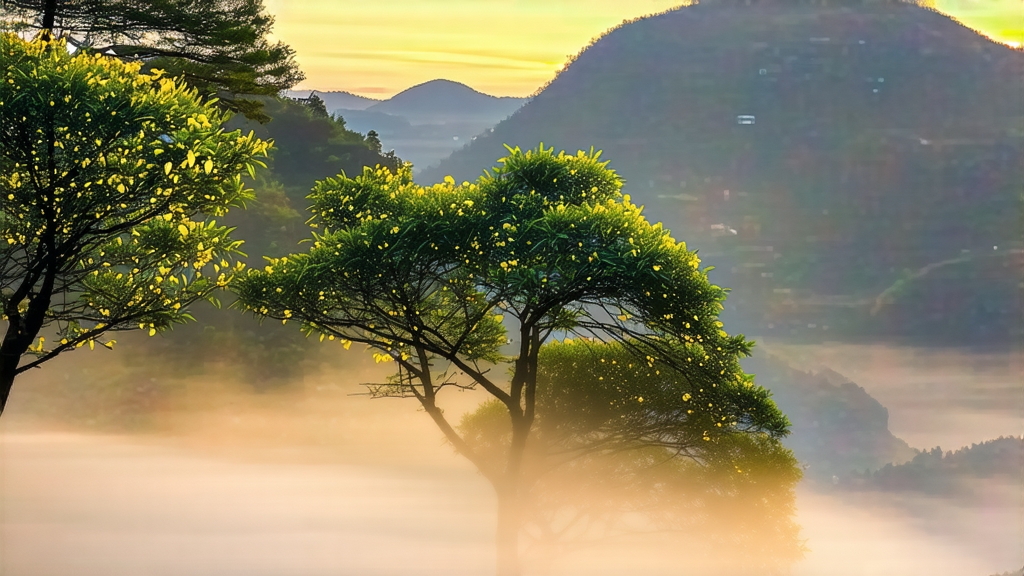
High on the shoulders of Sichuan’s sacred Meng Ding, where the Min River bends like a silk ribbon through perpetual cloud, grows one of China’s most elusive yellow teas—Meng Ding Huang Ya. Unlike the green teas that crown the same slopes or the dark pu-erhs that travel westward, this “yellow bud” tea has spent centuries hiding in plain sight, its pale-gold liquor once reserved for emperors, its craft guarded by monks and merchants who spoke of it only in hushed tones. Today, as global palates hunt for nuance beyond the familiar greens and blacks, Meng Ding Huang Ya is quietly re-emerging, offering a cup that tastes like late-afternoon sunlight filtered through bamboo—soft, sweet, and faintly reminiscent of warm hay.
Historical whispers place the tea’s birth during the Tang dynasty (618-907 CE), when Meng Ding’s monasteries served tea to scholars traveling the Silk Road’s southern spur. By the Song era, local gazetteers record “meng ding huang ya” among the 18 tribute teas escorted each spring to the capital in exchange for imperial favor. Caravans left Ya’an with bricks of compressed leaf, but the most tender buds—plucked only when the mountain’s own wild sparrows began to sing—were packed in bamboo tubes lined with aloe-scented paper and rushed by fast horses to Chang’an. Legend claims that Empress Wu Zetian, herself a Sichuan native, so cherished the tea’s buttery finish that she exempted Meng Ding monks from corvée labor. Whether myth or fact, the story cemented the tea’s reputation as “gong cha,” imperial tea, a status it held with intermittent lapses until the late Qing, when courtly fashions shifted to darker, oxidized leaves.
Meng Ding Huang Ya is not a single garden but a micro-region stretching across three parallel ridges—Gan Hai, Shang Qing, and Tian Gang—each differing in altitude, soil mica content, and morning fog density. Purists recognize three sub-styles. “Ya Shi” (Duck Beak) refers to the smallest, most perfectly pointed buds harvested before the Qingming festival; the leaves steep into a liquor the color of chrysanthemum hearts. “Huang Pian” (Yellow Slice) includes one unfurled leaf accompanying the bud, yielding a slightly grassier note favored by older farmers who still remember the tea being pressed into yak-butter bricks for Tibetan trade. Finally, “Cang Zhu” (Hidden Bamboo) is an experimental micro-lot aged six months in roasted bamboo cylinders, absorbing faint smoky phenols that echo distant campfires. All three, however, must conform to one unbreakable rule: every kilo demands between 60,000 and 80,000 hand-picked buds, plucked between 5:30 and 9:00 a.m. while the mountain’s dew still weighs exactly 0.38 grams per bud—an ancestral metric once tested by balancing a silver coin on the leaf’s spine.
The craft that turns a green bud into a yellow one is called “sealed yellowing,” men huang in Chinese. Within two hours of plucking, the buds are spread on bamboo trays and left to wither for 20 minutes in a draft-free chamber kept at 28 °C and 75 % humidity. This brief sweat encourages primary oxidation enzymes, but the leaf is then pan-fired at 160 °C for exactly 90 seconds, a shock that halts browning yet leaves the cuticle intact. What follows is unique: the warm buds are wrapped in thin cotton cloth, stacked in cedar boxes, and left to suffocate for 60 to 72 hours. During this interval, endogenous moisture migrates outward, re-activating non-enzymatic browning that tints the trichomes a pale champagne. Master wrappers judge readiness by ear—when the bundle rustles like silk slipping over jade, the yellowing is complete. A final low-temperature bake at 80 °C for 40 minutes sets the aroma, after which the tea rests for one lunar month so that residual maillard compounds settle into the signature honeyed note locals call “gui hua xiang,” osmanthus breath.
To brew Meng Ding Huang Ya is to court subtlety. Begin with soft mountain water; the tea’s delicacy collapses under mineral heaviness. Heat the water to 85 °C—any hotter scalps the amino acids, any cooler fails to coax the lactones